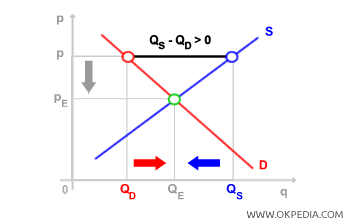Excess Supply
Excess supply is a market condition where the supply of a good surpasses the market demand. When the quantity demanded QD(p) and the quantity supplied QS(p) are compared, the excess supply is defined as the positive difference QS(p) - QD(p) (known as the excess supply function).
In this situation, businesses are offering a higher quantity of the good or service than what buyers (consumers or other businesses) are willing to purchase. This often occurs when the selling price is above the equilibrium price.
Excess supply pushes businesses to lower the price of the good (p). As the price (p) decreases, it reduces the economic revenue for businesses, prompting them to cut back on the quantity they produce, QS(p). At the same time, the lower price increases market demand QD(p), thereby reducing the excess supply. This scenario can be visually represented on a Cartesian graph as follows:

The adjustment process moves the market towards equilibrium, where, at an equilibrium price PE, the quantity supplied QS(pE) equals the quantity demanded QD(pE). When the market reaches equilibrium, the excess supply is resolved, resulting in QS(p) - QD(p) = 0.
Aggregate Excess Supply
Aggregate excess supply measures the overall surplus of goods and services available compared to the aggregate demand. When aggregate demand is lower than the available aggregate supply (production value), it leads to an increase in business inventories (unsold products), causing stockpiles and a decline in prices (deflation). In the short term, this encourages businesses to reduce their output, and in the long term, it may lead to a decrease in their production capacity.
